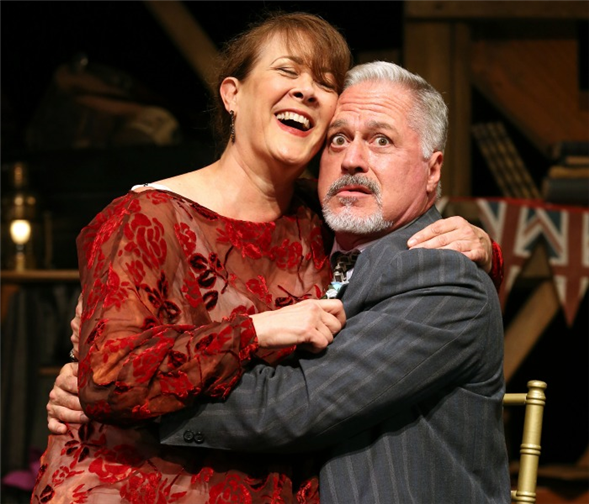Translate Page

How the late Hermione Gingold inspired this new take on Shaw's antiwar comedy
---
The spirit of Hermione Gingold permeates the new mounting of George Bernard Shaw's Heartbreak House at Off-Broadway's Lion Theatre. Produced by Gingold Theatrical Group, which is named in honor of the late British character actress (the films Gigi and The Music Man; Broadway's original A Little Night Music), the 1920 antiwar comedy in the country has been reset in the basement of a theatre during the London Blitz as a troupe valiantly performs the show while waiting out an air raid. That's a situation Gingold herself experienced many times during World War II.
"I loved hearing about Hermione's escapades during the War," says David Staller, the artistic director of Gingold Theatrical Group who also helms Heartbreak House. "It was a time when, along with everyone else in London, she never knew if she would make it through to morning because, starting every night at eight o'clock and going on until 6am, the Nazis indiscriminately bombed the city. It has always moved me greatly. We certainly have never had that in our country."
Gingold was starring in a satirical revue at the Ambassadors Theatre during that period. When the sirens went off, the actors and the audience took shelter in the basement. "To keep spirits up, the performers put on plays in a kind of stage area they created, and the most often requested play was Heartbreak House," Staller recalls Gingold telling him. "Every night they would switch roles -- Hermione played them all, but she most loved to play the old Captain Shotover." Subtitled "A Fantasia in the Russian Manner on English Themes," Heartbreak House intentionally recalls the plays of Anton Chekhov as a group of eclectic and lovesick characters converge at Shotover's country house, unaware that their anxieties over money and romance may soon be overshadowed by an uncertain future.
It was Gingold, a longtime family friend, who sparked Staller's passion for Shaw. In the late '70s, the two hosted readings of the great Irish dramatist's plays in Gingold's NYC apartment with a revolving roster of actors. Since founding Gingold Theatrical Group in 2006, Staller has continued that tradition with monthly Project Shaw presentations of his 65 pieces for the stage, including sketches and one-acts. The company has also coproduced full-fledged stagings of Shaw's shows such as Man and Superman with Irish Repertory Theatre and Major Barbara with the now-defunct Pearl Theatre Company. Heartbreak House marks Gingold Theatrical Group's first solo production.
{Image1}
Even though the play is almost 80 years old and was last seen on Broadway in 2006, Staller insists Heartbreak House speaks directly to what we're going through today politically. "Shaw wrote this play to encourage us to wake up -- to be responsible people in a society in which we can no longer be observers or passive," he says. Shaw actually penned the play during the lead-up to World War I, but set it aside due to criticism. "Two years after the war ended he got the Theater Guild in New York to produce it," says Staller. "But rather than keeping its setting at the beginning of the war as a warning, he rewrote it so that it was bit more wistful -- about the torment that the world been through, and the hope that it would never happen again."
Working from a copy of Shaw's original handwritten manuscript and drawing from subsequent versions of the play, Staller has adapted Heartbreak House to fit the original time frame of 1914. "I've been extremely careful to question every change, cut or addition, to make sure the story we are telling is the story that Shaw gave to us," Staller says, noting that the WWII framing device is the biggest adjustment.
The cast of Heartbreak House features an impressive lineup of theatre vets, including Tony winner Karen Ziemba; Tony nominees Alison Fraser and Tom Hewitt; Broadway regular Lenny Wolpe and scene-stealer Jeff Hiller. "This is hard material," Staller says. "It requires the same kind of discipline as Shakespeare -- you can't wing it. And it helps that all these actors have done musicals. Shaw was a musician and he started his career as a music critic. All of his scenes are written as arias, duets, trios, quartets."
While Staller's primary goal with Heartbreak House is to entertain audiences, he hopes the play's unique presentation will also enlighten. "I want to share Shaw's ideas with others: his precepts, beliefs and his love and encouragement of the best of humanity," Staller says. "I would like audiences to feel a sense of community, to find some way to deal with the fear by knowing that we are all in this together. Even if we get a direct hit -- which we seem to be getting every day in the news -- we'll get through to tomorrow." Just like Gingold did back in the day.
To read about a student's experience at Heartbreak House, check out this post on TDF's sister site SEEN.
---
TDF MEMBERS: At press time, discount tickets were available for Heartbreak House. Go here to browse our current offers.
Gerard Raymond is an arts journalist based in New York City.
Karen Ziemba and Tom Hewitt in Heartbreak House. Photos by Carol Rosegg.